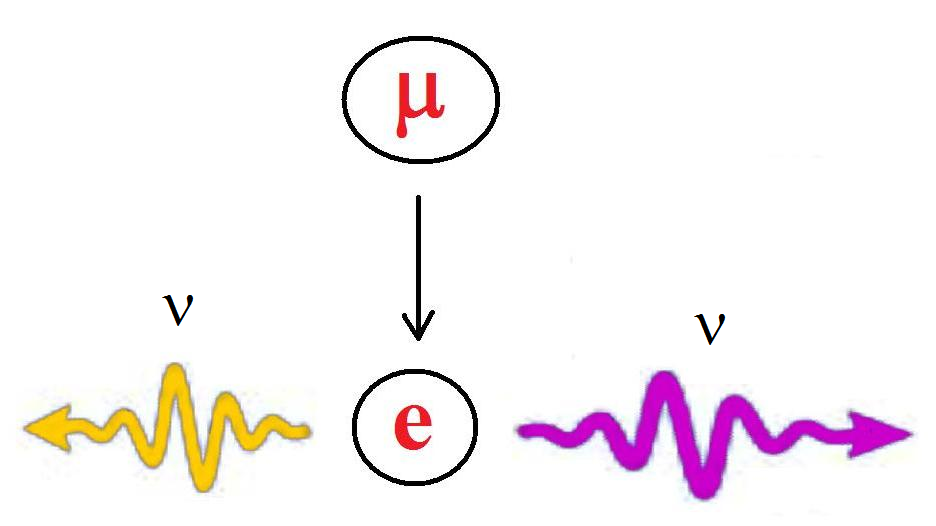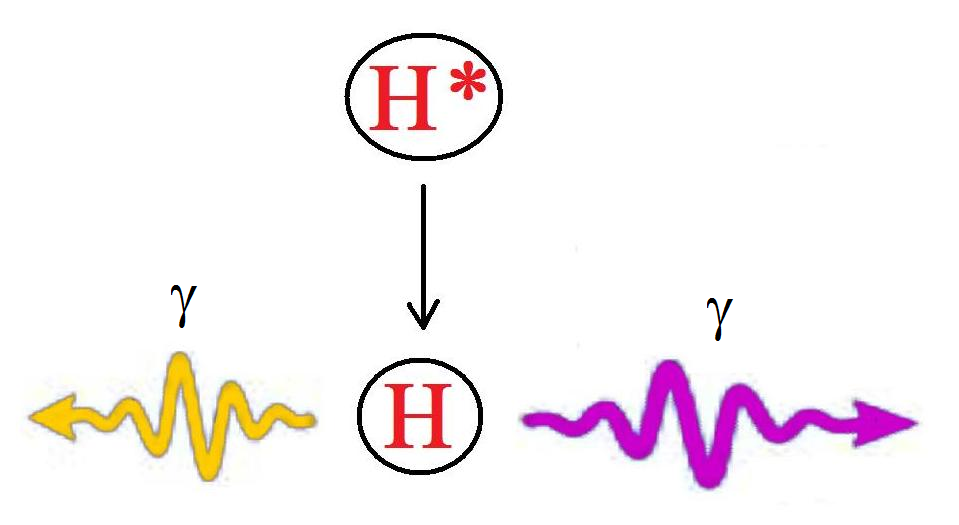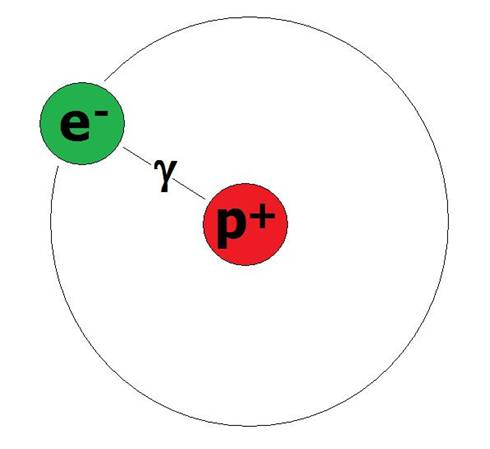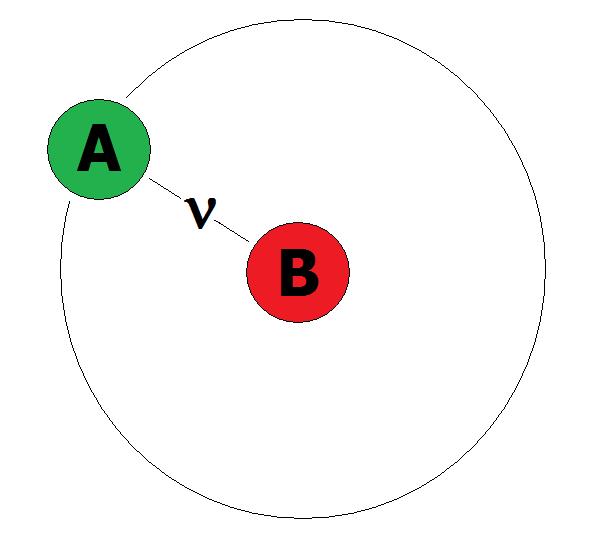It looks like you're using an Ad Blocker.
Please white-list or disable AboveTopSecret.com in your ad-blocking tool.
Thank you.
Some features of ATS will be disabled while you continue to use an ad-blocker.
3
share:
The first observation relevant to the ABC Preon Model occurred to me when I was a graduate student in the very early 1980's. I noticed that the decay
of the muon was extremely similar to the decay of a hydrogen atom from an excited state into its ground state. Below we see drawings of the two
events. In the first drawing, we can see a muon decay. The muon decays into an electron, and two neutrinos. Neutrinos were believed to be either
massless or nearly so.

In the second drawing, we see hydrogen excited into its 2s state decaying into its ground state by emitting two photons. The photons are believed to be massless.

Notice that muon decay appears in many ways to be similar to the decay of hydrogen from its 2s state. A muon decays into an electron by emitting two neutrinos, while a hydrogen atom in its 2s state decays into a hydrogen atom in its 1s state by emitting two photons. Here we introduce the standard notation for neutrinos and photons by denoting a neutrino by the Greek letter nu, and a photon by the Greek letter gamma. It is known that the hydrogen atom is very effectively modeled as a proton and an electron being bound by a photon, and therefore the starting point for the ABC Preon Model is to propose that the massive leptons consist of two new particles, called preons, bound by a neutrino. The word preon is meant to confer a precursor particle to the ones presently assumed to be elementary, and that is why I refer to this new model as a preon model.
Below we see pictures of the internal structure of the hydrogen atom and our proposed preon model of the massive leptons. In the Hydrogen atom, an electron orbits a proton, and the force is carried by a photon:

In our newly proposed massive lepton model, we will propose an analogous substructure with one particle orbiting another. From experiment, we observe that hydrogen decays into its ground state by emitting photons, and a photon is the carrier of the force that binds it. Hence, since muons decay into electrons by emitting neutrinos, it follows from our analogy that the force that binds the preons together to form massive leptons is carried by the neutrino. Therefore a neutrino is shown as the binding quanta in the picture. At this point in the development we will simply name the preons "A" and "B" and we will investigate their properties later on, in future threads:

I want to emphasize how simple the onset of this new elementary particle model is. We simply look at the decay processes of Hydrogen and muons and propose that the internal structure of the muon is composed analogously to the internal structure of hydrogen. Since the radiated particle is a neutrino instead of a photon, we replace the photon by the neutrino. It is all just a simple observation at this point.
We've just seen how our analogy with the hydrogen atom has led to a proposal that the muon is the second quantum state of a composite system, and that the electron is the first quantum state. Of course, there is a third massive lepton, the tauon, that also has properties nearly identical to the muon and the electron, but with an even heavier mass. In the model proposed here, it is easy to identify the tauon as being the next excited state of the same composite system. And while the force binding the preon particles together is quite strong, neutrinos can still flow freely through matter as long as the cross section for the interaction is low. This is similar to the fact that some photons flow relatively freely through glass.

In the second drawing, we see hydrogen excited into its 2s state decaying into its ground state by emitting two photons. The photons are believed to be massless.

Notice that muon decay appears in many ways to be similar to the decay of hydrogen from its 2s state. A muon decays into an electron by emitting two neutrinos, while a hydrogen atom in its 2s state decays into a hydrogen atom in its 1s state by emitting two photons. Here we introduce the standard notation for neutrinos and photons by denoting a neutrino by the Greek letter nu, and a photon by the Greek letter gamma. It is known that the hydrogen atom is very effectively modeled as a proton and an electron being bound by a photon, and therefore the starting point for the ABC Preon Model is to propose that the massive leptons consist of two new particles, called preons, bound by a neutrino. The word preon is meant to confer a precursor particle to the ones presently assumed to be elementary, and that is why I refer to this new model as a preon model.
Below we see pictures of the internal structure of the hydrogen atom and our proposed preon model of the massive leptons. In the Hydrogen atom, an electron orbits a proton, and the force is carried by a photon:

In our newly proposed massive lepton model, we will propose an analogous substructure with one particle orbiting another. From experiment, we observe that hydrogen decays into its ground state by emitting photons, and a photon is the carrier of the force that binds it. Hence, since muons decay into electrons by emitting neutrinos, it follows from our analogy that the force that binds the preons together to form massive leptons is carried by the neutrino. Therefore a neutrino is shown as the binding quanta in the picture. At this point in the development we will simply name the preons "A" and "B" and we will investigate their properties later on, in future threads:

I want to emphasize how simple the onset of this new elementary particle model is. We simply look at the decay processes of Hydrogen and muons and propose that the internal structure of the muon is composed analogously to the internal structure of hydrogen. Since the radiated particle is a neutrino instead of a photon, we replace the photon by the neutrino. It is all just a simple observation at this point.
We've just seen how our analogy with the hydrogen atom has led to a proposal that the muon is the second quantum state of a composite system, and that the electron is the first quantum state. Of course, there is a third massive lepton, the tauon, that also has properties nearly identical to the muon and the electron, but with an even heavier mass. In the model proposed here, it is easy to identify the tauon as being the next excited state of the same composite system. And while the force binding the preon particles together is quite strong, neutrinos can still flow freely through matter as long as the cross section for the interaction is low. This is similar to the fact that some photons flow relatively freely through glass.
The Exposition of the ABC Preon Model will involve many threads. Here are links to previous threads in this series, in the order that they
appeared:
The ABC Preon Model, Background: the Standard Model of Elementary Particle Physics
The ABC Preon Model, Background: the Standard Model of Elementary Particle Physics
a reply to: delbertlarson
Again, as when this basic thread was posted a couple of days ago, the mass of us out here wallowing in gross ignorance have little idea of what this all means to us and our world. Could you bring this new hypothesis down to earth for us?
Again, as when this basic thread was posted a couple of days ago, the mass of us out here wallowing in gross ignorance have little idea of what this all means to us and our world. Could you bring this new hypothesis down to earth for us?
originally posted by: Aliensun
a reply to: delbertlarson
Again, as when this basic thread was posted a couple of days ago, the mass of us out here wallowing in gross ignorance have little idea of what this all means to us and our world. Could you bring this new hypothesis down to earth for us?
Both the Standard Model and the ABC Preon Model are models for elementary particle physics, which is the study of the ultimate building blocks of nature. The quest to answer the question "What is the World Made of?" is one of the great philosophical undertakings that has occupied mankind's thoughts since the ancient Greeks.
As for elements, in the ancient model, the world was thought to be composed of four elements - earth, fire, air and water. As history unfolded, additional elements were found and added to the list. Around the late middle ages, chemistry replaced the earth, fire, air and water model with a model of chemical elements. But the chemical element model was complex, as it involved around 100 elements, some of which came in multiple isotopic varieties. By the 1930's it was appreciated that all elements were actually made up of three sub-atomic particles - the electron, proton, and neutron. However, by the 1950's, experimentation with beams resulting from accelerators showed that there were vastly more sub-atomic particles - so many, that the situation was called "the particle zoo". In the mid-1960's it was theorized that the particles of the particle zoo could all be understood in terms of underlying particles called quarks and leptons. Today, the quark and lepton model has so many particle members that I call it "the quark and lepton zoo", and the ABC Preon Model will show that there is a much simpler underpinning for all particles known to exist.
Along with our increasing knowledge of elements (particles) we have also evolved in our knowledge concerning the forces that act within our world. Newton proposed several valuable laws, including a law of the gravitational force. Several scientists contributed to the study of electricity and magnetism, leading up to Maxwell's equations. Lorentz and others found modifications to Newton's force laws in the early 1900's. The Standard Model has increased our knowledge with the elucidation of two more forces - the strong and the weak, as well as modifications to gravity. The ABC Preon Model advances our knowledge further, by identifying what is believed to be the weak force with simple quantum tunneling, further refining our knowledge.
Now you might say, well, that's nice, but what does it mean for me? And the answer is that if you evaluate technological advances made in the past two millennia, a great many of them can be seen to spring from our knowledge of chemistry, electricity, magnetism, and force laws. Understanding electricity and magnetism has led to electric power and electric lights. Understanding quantum mechanics, along with the prior advances in electromagnetism, led to the microchip and modern computing and phones. And these are of course just minimal examples - there are vastly more. If we next can more fully understand the nuclear force it may lead to further significant advances. For one thing, we know the sun to be powered by fusion, and if we know enough we could perhaps put fusion generation devices on a chip, resulting in clean, safe (if we use a-neutronic fusion), and unlimited power. And that is just one example, as it is of course hard to predict what uses may come once we are in a position to use any newly found knowledge.
originally posted by: moebius
a reply to: delbertlarson
You are missing the other muon decay modes.
At the outset, only the dominant decay mode is being considered. Since the ABC Preon Model will be shown in future threads to dovetail into the Standard Model, other phenomena consistent with the Standard Model (including particle/anti-particle creation from the vacuum) are possible. Importantly, in addition to improving the underlying simplicity, the ABC Preon Model will also predict several events not presently predicted by the Standard Model.
One problem I have with it are that all the force carriers are normally bosons, yet the neutrino is a fermion.
The force that binds the H atom is electromagnetism. What is your corresponding force involving the neutrino?
The force that binds the H atom is electromagnetism. What is your corresponding force involving the neutrino?
While I appreciate the model, it is not really a correct analogy to excited states of hydrogen.
The Hydrogen atom is a bound state of an electron and proton. When it is in an excited state, the electron is in a higher quantum state and can decay radiatively emitting a photon... the photon leaves the system, it does not bind the electron to the nucleus.
leptons have not been shown to exist in excited states on their own, and if as you present, the model you claim that leptons are in some manner bound preons... This appears logically not the same since if you say that a lepton is a bound state of two preons then once it decays, you get
A nu B (muon) goes to A nu B (electron) + nu in the claim that the switch is basically just the neutrino.
What actually happens in these events is that the muon decays and you produce a electron, muon neutrino and electron neutrino. They are of distinctive flavour.
Also to claim the neutrino travels through material because its weakly interacting similar to photons through glass is also misleading given that the process is completely governed by atomic physics in a molecular system... neutrinos in this case should thus interact with different materials dependant upon how the leptons are bound... bearing in mind that by your own mechanism, the leptons themselves now are flavoured as excited states rather than leptons in their own right.
This does not simplify things.
There are also 3 known decay modes and 4 forbidden modes with very low probability.
The Hydrogen atom is a bound state of an electron and proton. When it is in an excited state, the electron is in a higher quantum state and can decay radiatively emitting a photon... the photon leaves the system, it does not bind the electron to the nucleus.
leptons have not been shown to exist in excited states on their own, and if as you present, the model you claim that leptons are in some manner bound preons... This appears logically not the same since if you say that a lepton is a bound state of two preons then once it decays, you get
A nu B (muon) goes to A nu B (electron) + nu in the claim that the switch is basically just the neutrino.
What actually happens in these events is that the muon decays and you produce a electron, muon neutrino and electron neutrino. They are of distinctive flavour.
Also to claim the neutrino travels through material because its weakly interacting similar to photons through glass is also misleading given that the process is completely governed by atomic physics in a molecular system... neutrinos in this case should thus interact with different materials dependant upon how the leptons are bound... bearing in mind that by your own mechanism, the leptons themselves now are flavoured as excited states rather than leptons in their own right.
This does not simplify things.
There are also 3 known decay modes and 4 forbidden modes with very low probability.
originally posted by: Dr X
One problem I have with it are that all the force carriers are normally bosons, yet the neutrino is a fermion.
The force that binds the H atom is electromagnetism. What is your corresponding force involving the neutrino?
Thank you for mentioning this, as it is usually the first objection raised. It is sometimes even declared that fermions cannot be force carriers, and I believe this objection is typically founded with contemporary treatments of QED, since the vertices of Feynman would result in entities changing their nature if a single fermion is used as a force carrier. (A fermion would become a boson if it emits a fermion at the vertex.) I believe this objection can be met with a few observations. The first is that Feynman diagrams are a representation of a perturbation series, and one could have a series that only involves the even terms (having two, then four, etc., fermions leaving the vertex would leave everything OK). And secondly, once we get into a new force, it is not at all obvious that the same descriptions used in QED will apply to that new force. I have called the force carried by the neutrino the "neutrinic force" and as of now I still struggle with characterizing it well. However, even in the absence of a well defined dyanmics it will be shown in future threads that the ABC Preon Model makes many sound predictions concerning high energy physics, both qualitatively and quantitatively. I will readily admit that more work is needed regarding the neutrinic force, but we must make progress one step at a time of course.
originally posted by: ErosA433
While I appreciate the model, it is not really a correct analogy to excited states of hydrogen.
The Hydrogen atom is a bound state of an electron and proton. When it is in an excited state, the electron is in a higher quantum state and can decay radiatively emitting a photon... the photon leaves the system, it does not bind the electron to the nucleus.
leptons have not been shown to exist in excited states on their own, and if as you present, the model you claim that leptons are in some manner bound preons... This appears logically not the same since if you say that a lepton is a bound state of two preons then once it decays, you get
A nu B (muon) goes to A nu B (electron) + nu in the claim that the switch is basically just the neutrino.
What actually happens in these events is that the muon decays and you produce a electron, muon neutrino and electron neutrino. They are of distinctive flavour.
Also to claim the neutrino travels through material because its weakly interacting similar to photons through glass is also misleading given that the process is completely governed by atomic physics in a molecular system... neutrinos in this case should thus interact with different materials dependant upon how the leptons are bound... bearing in mind that by your own mechanism, the leptons themselves now are flavoured as excited states rather than leptons in their own right.
This does not simplify things.
There are also 3 known decay modes and 4 forbidden modes with very low probability.
What I am proposing is that the massive leptons are three body states comprised of two preons and a neutrino. I have also been of the opinion that hydrogen contains an electron, a proton and a photon, with the photon being a quanta of the electromagnetic field that binds the electron to the proton within the atom. I don't know that the latter opinion can be either proved or disproved. I do know that the former proposal is what the ABC Preon Model is founded upon.
In both radiations shown in the drawings above, two quanta of the force carrier leave the bound systems. For each bound system, one binding quanta is contained within. Hence, as you say, photons will leave during the decay (two in the case of 2s to 1s hydrogen transitions, as that is quadrupole radiation) but the quanta leaving are not the same as the quanta presumed to exist within the bound entities. I regret if I was not clear, and greatly appreciate comments that help to make things clearer.
I addressed the issue of neutrino flavors in my 20 year old original publication as well, as within the ABC Preon Model the neutrino should ideally not have flavors. Indeed that is what led to the prediction that neutrino oscillations should exist. The cross sections might be small, but that is why I believed oscillations should occur at some level.
As for simplicity, I will show that one can replace the 61 particles of the Standard Model by eight particles in the ABC Preon Model, with the generational problem being cleanly addressed as indicating various excited state levels of bound preon systems. It is the underlying number of particles and forces that results in the simplicity I refer to. Clearly, replacing a simple electron (or other massive lepton) by a three component system does complicate what we think massive leptons to be, so I didn't mean things are simpler in that sense.
The ABC Preon Model is a rather radical departure from present understanding. The critical thing of course is whether it violates experimental results, and I don't believe it does.
new topics
-
Happy Thanksgiving to ATS
General Chit Chat: 2 hours ago -
Simple Thanksgiving
Food and Cooking: 9 hours ago
top topics
-
V.P. Kamala Harris releases a video and nobody understands why
US Political Madness: 17 hours ago, 16 flags -
Mind Blowing Cave under someones land
Fragile Earth: 13 hours ago, 16 flags -
The Party of Peace - Trump Cabinet Picks Targeted with Death Threats
US Political Madness: 14 hours ago, 15 flags -
Trump could make a peaceful American Revolution
US Political Madness: 12 hours ago, 14 flags -
Simple Thanksgiving
Food and Cooking: 9 hours ago, 14 flags -
Trump Presidential Transition Team will not use GSA or Government entities to come to DC
US Political Madness: 13 hours ago, 13 flags -
Happy Thanksgiving to ATS
General Chit Chat: 2 hours ago, 5 flags
active topics
-
Trump Presidential Transition Team will not use GSA or Government entities to come to DC
US Political Madness • 13 • : angelchemuel -
Petition Calling for General Election at 564,016 and rising Fast
Political Issues • 106 • : angelchemuel -
Happy Thanksgiving to ATS
General Chit Chat • 3 • : IceHappy -
Simple Thanksgiving
Food and Cooking • 27 • : Owlwatcher -
Mind Blowing Cave under someones land
Fragile Earth • 17 • : Owlwatcher -
The Party of Peace - Trump Cabinet Picks Targeted with Death Threats
US Political Madness • 27 • : DBCowboy -
President-Elect DONALD TRUMP's 2nd-Term Administration Takes Shape.
Political Ideology • 256 • : WeMustCare -
-@TH3WH17ERABB17- -Q- ---TIME TO SHOW THE WORLD--- -Part- --44--
Dissecting Disinformation • 3389 • : Crazierfox -
I thought Trump was the existential threat?
World War Three • 113 • : WeMustCare -
Mood Music Part VI
Music • 3719 • : MRTrismegistus
3
